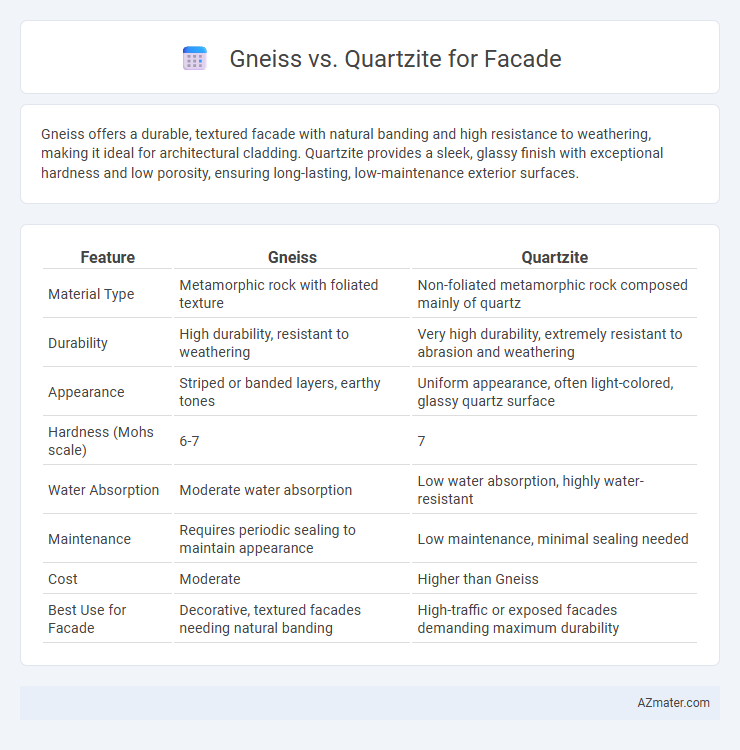Gneiss offers a durable, textured facade with natural banding and high resistance to weathering, making it ideal for architectural cladding. Quartzite provides a sleek, glassy finish with exceptional hardness and low porosity, ensuring long-lasting, low-maintenance exterior surfaces.
Table of Comparison
| Feature | Gneiss | Quartzite |
|---|---|---|
| Material Type | Metamorphic rock with foliated texture | Non-foliated metamorphic rock composed mainly of quartz |
| Durability | High durability, resistant to weathering | Very high durability, extremely resistant to abrasion and weathering |
| Appearance | Striped or banded layers, earthy tones | Uniform appearance, often light-colored, glassy quartz surface |
| Hardness (Mohs scale) | 6-7 | 7 |
| Water Absorption | Moderate water absorption | Low water absorption, highly water-resistant |
| Maintenance | Requires periodic sealing to maintain appearance | Low maintenance, minimal sealing needed |
| Cost | Moderate | Higher than Gneiss |
| Best Use for Facade | Decorative, textured facades needing natural banding | High-traffic or exposed facades demanding maximum durability |
Introduction to Gneiss and Quartzite
Gneiss and quartzite are both durable metamorphic rocks commonly used for facades, each offering unique aesthetic and structural qualities. Gneiss is characterized by its distinct banding and foliation, formed under intense heat and pressure from granite or sedimentary rocks, providing a textured, layered appearance. Quartzite originates from quartz-rich sandstone subjected to metamorphism, resulting in a hard, non-foliated surface with high resistance to weathering, ideal for long-lasting exterior cladding.
Geological Formation and Composition
Gneiss forms through high-grade regional metamorphism of granite or sedimentary rock, characterized by its foliated texture with alternating light and dark mineral bands, primarily composed of quartz, feldspar, and mica. Quartzite originates from the metamorphism of pure quartz sandstone under intense heat and pressure, resulting in an extremely hard, non-foliated rock predominantly made of interlocking quartz grains. The distinct geological origins and mineral compositions influence their durability and aesthetic appeal for building facades, with gneiss offering a textured, banded appearance and quartzite providing a smooth, glassy finish.
Visual Appearance and Color Variations
Gneiss offers a striking visual appearance characterized by its banded texture and complex, swirling patterns, featuring earthy tones like gray, brown, and beige that create a dynamic facade. Quartzite provides a smoother and more uniform look with a glassy texture and vibrant color variations ranging from white and gray to pink and blue, enhancing modern architectural designs. Both materials withstand weathering well, but gneiss's layered look suits rustic, natural aesthetics while quartzite's bold colors support sleek, contemporary facades.
Strength and Durability Comparison
Gneiss exhibits exceptional strength due to its foliated structure and high quartz and feldspar content, making it highly resistant to weathering and mechanical stress. Quartzite, formed from metamorphosed sandstone, offers superior hardness and abrasion resistance, enhancing its durability for facade applications in harsh environments. Both materials provide excellent long-term performance, with gneiss favored for structural resilience and quartzite prized for its resistance to surface wear and environmental degradation.
Weather Resistance for Facade Applications
Gneiss and quartzite are both highly durable natural stones, but quartzite demonstrates superior weather resistance for facade applications due to its dense, non-porous structure that resists moisture absorption and freeze-thaw cycles effectively. Gneiss, while sturdy, contains mineral bands that may weather unevenly under harsh environmental conditions, potentially leading to surface erosion and discoloration over time. Quartzite's hardness and low porosity make it a preferred choice for facades in regions experiencing extreme weather changes, ensuring long-term structural integrity and minimal maintenance.
Maintenance and Longevity
Gneiss offers excellent durability and low maintenance due to its foliated structure, making it resistant to weathering and suitable for exterior facades. Quartzite, characterized by its dense and non-foliated crystalline texture, provides superior hardness and exceptional resistance to abrasion and chemical weathering, ensuring long-term facade resilience. Both materials maintain aesthetic appeal with minimal upkeep, but quartzite's higher resistance to erosion typically results in longer-lasting facades in harsh environmental conditions.
Cost Factors and Budget Considerations
Gneiss generally offers a more cost-effective option for facades due to its abundant availability and easier quarrying process compared to quartzite, which tends to be more expensive because of its hardness and durability. Budget considerations must include not only initial material and installation costs but also long-term maintenance, with quartzite requiring less upkeep and offering better resistance to weathering. Choosing between gneiss and quartzite depends on balancing upfront expenditures with lifecycle costs and aesthetic preferences in facade design.
Installation Challenges and Requirements
Gneiss and quartzite facades both demand precise installation techniques due to their natural stone properties, with gneiss requiring careful alignment to accommodate its foliated texture and prevent delamination. Quartzite, known for its extreme hardness and density, poses challenges in cutting and anchoring, necessitating specialized tools and experienced labor to avoid fracturing. Proper substrate preparation, use of flexible adhesives or mechanical anchors, and allowance for thermal expansion are critical installation requirements for both stones to ensure durability and structural integrity in exterior cladding applications.
Sustainability and Environmental Impact
Gneiss and quartzite both provide durable options for facade cladding with high resistance to weathering, but quartzite's higher silica content often results in greater hardness and longevity, reducing the need for replacements over time. Gneiss typically has lower embodied energy due to less intensive quarrying and processing compared to quartzite, making it a more sustainable choice in terms of carbon footprint. Selecting natural stones like gneiss or quartzite enhances facade sustainability by offering recyclability and minimal chemical treatment requirements.
Best Use Cases: Choosing the Right Stone for Your Facade
Gneiss offers excellent durability and a distinctive foliated texture, making it ideal for rustic or natural-style facades that emphasize earthy, layered aesthetics. Quartzite, known for its hardness and resistance to weathering, suits sleek, modern facades that require minimal maintenance and a polished, uniform appearance. Selecting between gneiss and quartzite depends on desired visual effects and environmental exposure, with gneiss favored for textured depth and quartzite preferred for longevity in harsh climates.

Infographic: Gneiss vs Quartzite for Facade
 azmater.com
azmater.com